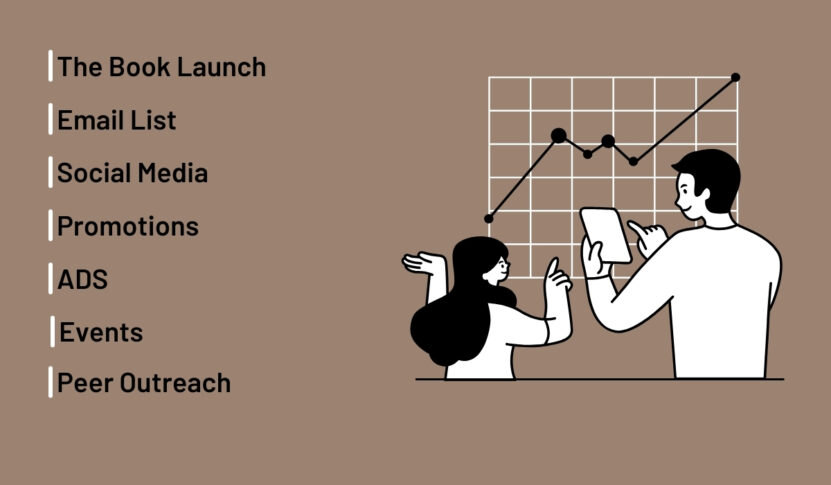Selling your book can be tough, right? Well, you’re not alone – lots of authors have trouble getting people to buy their books. But if you don’t have a good plan to tell people about your book, it will just get lost in the sea of all the other books out there.
Before anything, figure out your budget, know your audience, fix any issues with your book, understand your competition, define your marketing goals, and gather your promotional materials. This is your toolkit for the marketing journey!
So in this article, we will gonna give you a few easy steps to make the best marketing plan for first book. And we’re gonna focus on a plan that will keep selling your book over time.
What Is a Book Marketing Plan?
Whether you’re writing a romance novel or a war novel, a book marketing plan is important when you put out a new book. It’s how you tell everyone about your book and get them to buy it. A good plan can help your book reach the right readers, get more attention, and sell the most copies possible.
First, you gotta figure out who likes the kind of book you wrote. Where do they hang out online? What’s the best way to tell them about your book?
Once you know that, you need to set some goals for your plan like becoming famous as an author or getting more people interested in your new book. Once you pick your goals, then comes the fun part – making a list of things you can do to tell everyone about your book! This includes using Facebook and Twitter, getting bloggers to talk about it, emailing readers, and other online activities.
Begin by Preparing
1. Money

You’re probably gonna need to spend some cash to tell people about your book. Don’t stress if you don’t have a lot – you can still do stuff for free. But at some point, you’ll need money for promotions. That’s why you gotta set a budget first.
Decide how much dough you can use to market your book. Knowing your budget ahead of time will help you pick promotions you can afford to do. A budget might seem boring, but trust us – it will save you a lot of headaches later on. If you don’t plan how much cash you have to work with, you might try to do something too expensive!
2. Your Readers
You wanna know who likes your kind of book. Well if you don’t already, take some time to figure it out. Read other books in your genre and talk to people who read stuff like yours. The more you understand who wants to read your book, the better you can promote it to them.
3. Check for Problems
See if there’s anything you need to fix with your book first. Maybe the cover art doesn’t match the genre or the description needs work. If so, fix it before spending time on promotions. Your plan won’t work well if the book itself has issues.
4. Know the Competition
Find out who else writes books similar to yours. See how you can stand out while still doing what your readers love. Knowing the competition will help you make your promotions better than theirs.
5. Set Goals
You gotta have a plan for where you’re going with this, right? Decide what you want to achieve like getting more fans or hitting a sales goal. Also, set little goals you can do quickly so you feel like you’re making progress.
6. Promotion Stuff
Now’s a good time to make things you can use to tell people about your book, like images for social media. Programs like BookBrush can help you make cool stuff. How Much Does It Cost to Market A Book? An independent author can forgo professional publishing and may spend less than $200 to create their own marketing campaigns.
Self-marketing versus investing money in an actual publisher can be the difference between only selling a handful of books and succeeding on a spectacular level.
Components of Your Marketing Plan

1. The Book Launch
This part is so important as a marketing plan for the first book. A reader’s book launch is basically where their marketing plan gets started. But I don’t want to go too much into it here since there’s already a guide. During a launch, the reader will use some different tactics to sell their book. It takes a TON of work upfront and focuses a lot on Amazon.
For the rest of the reader’s long-term plan, we want to concentrate on strategies that will keep their book earning money for months or even years after launch. The stuff they can do steadily without burning out.
2. Email List
Email marketing is still the best way for an author to reach their target readers. There are lots of ways to promote, but email is great cause it lets the author “own” their list, and they don’t have to rely on social media algorithms. It’s really important for an author to always try growing their email list. Then they can send reminders about buying their books. Of course, you don’t wanna spam people.
But remember, selling books is how authors make their living! So every email should point readers toward purchasing. Emails are a good way for authors to connect with readers again and again. As long as emails are useful and not too sales-y, readers won’t mind an occasional reminder about an author’s books. Building an email list takes time, but it’s worth it to have direct contact with fans.
3. Social Media
It’s easy to get caught up in all the hype around different social media sites. Facebook, Twitter, Instagram – these sites are awesome for connecting with fans and spreading the word about your book. But here’s our advice – pick just ONE to focus on. Yup, don’t stress over trying to be on every platform out there. Doing that will burn you out from all the work. Plus it means your efforts are scattered everywhere instead of focused.
It’s much better to choose one site and really get great at using it. And pick the one where your readers spend the most time online. Figure out which social media your target audience uses the most. Then put all your energy into learning how to use that platform really well. Over time you’ll build more connections and followers thereby focusing instead of half-heartedly juggling too many sites.
4. Promotions
A solid book marketing plan should have some book promotions included. Promotions are when you lower the price of your book for a little while. Then you hire someone to help spread the word about it. Lots of services out there can do this – they usually charge a small fee but can really help if you play your cards right.
When your book is on sale for less money, more readers will take a chance on it. And the promoter will tell lots of people about your deal through social media, emails, and other ways. This can lead to a big boost in sales that makes up for the fee.
Promotions don’t have to be too long, sometimes even just a few days work well. And you don’t need to do them super often, maybe every few months. But they’re a nice way to attract new readers and put some extra cash in your pocket too.
5. ADS
Advertising is like a secret weapon for authors. It helps you sell your book and gives you important information. Sites like Amazon, Goodreads, and BookBub let you pay to promote your book. Test out different ad budgets to see what works best.
A little ad spending can go a long way toward getting new eyes on your story. Advertising is like a secret weapon for authors. It helps you sell your book and gives you important information.
6. Events
You’re an author, and your book is like a star waiting to shine. Now, picture a room filled with eager readers, all buzzing with excitement. That’s an event—a place where you can directly connect with your audience and sell your books.
- Book Launch Party: Think of it as your book’s birthday bash. You invite friends, family, and fans to celebrate your book’s arrival. There’s cake, confetti, and, most importantly, signed copies of your masterpiece.
- Conventions and Fairs: Imagine a colorful fairground or a bustling convention center. Authors set up booths, display their books, and chat with potential readers. It’s like a book bazaar!
- Workshops and Panels: You become the guru. Teach aspiring writers, share your journey, and drop wisdom bombs. Plus, you get to sneak in a plug for your book.
- Meet-and-Greets: Picture this: You, a cozy café, and a bunch of curious readers. They sip coffee, you sign books, and everyone leaves with a smile (and a copy of your book).
Now, here’s the twist: In our digital age, events aren’t the go-to strategy for everyone. But guess what? Some authors rock it! They sell stacks of books at events, and it’s magical.
7. Peer Outreach
- Dream 100: Picture your top 100 influencers—the ones whose support would make your book launch feel like a fairy tale. These influencers could be experts, authorities, or just really cool people in your niche.
- Realistic Expectations: Now, let’s be practical. Oprah might not swoop in to promote your book (although that would be epic!). Instead, focus on influencers who are within reach. Think YouTube channels, podcasts, and fellow authors who groove to the same genre beat.
- One by One: It’s like sending out secret invitations. Reach out to these influencers individually. Share your book’s magic, your passion, and why it’s worth their attention. Some will say no (cue dramatic music), but that’s okay.
- The Yes Effect: When one influencer says yes (hooray!), use that as your golden ticket. Leverage it to unlock more yeses. It’s like a domino effect—once one falls, the rest follow.
So, go forth, brave author! Dream big, reach out, and build your dream team. Your book deserves a spotlight, and these influencers can make it shine.
Book Marketing Pricing
As an author, you’re like a wizard conjuring a magical potion for your book. But here’s the thing: You don’t want to empty your treasure chest on marketing, especially if your book is just starting its adventure. Let’s break it down:
- The Big Expense: For self-publishing authors, the book cover and design are like the golden gates to your story. A stunning cover inspires readers, while a lackluster one can lead to confusion (and maybe even a dragon attack). If you’re not a Picasso with a pen, consider outsourcing this part.
- The Design Quest: Your marketing budget and genre hold the map. Palmetto Publishing, our trusty guide, partners with Getty Images to craft top-tier cover designs. For about $699, their design wizards create two concepts with quality images. They’ll even tweak it twice to match your vision. If your book cover is as intricate as a dragon’s scales, expect to pay around $899.
- DIY Magic: Now, some authors prefer the DIY route. Imagine brewing your own potion! An independent author can spend less than $200 on self-marketing. It’s like crafting spells, mixing ingredients, and chanting, “Buy my book!”
- The Grand Finale: Here’s the twist—self-marketing vs. investing in a publisher. It’s like choosing between a cozy cottage and a majestic castle. Both have their charm. Self-marketing might mean selling a handful of books (like a secret treasure stash). But with a publisher’s help, you could soar to spectacular heights!
So, fellow wordsmith, choose wisely. Your book’s destiny awaits!
Organize Your Book Promotion Schedule

We saw how important is to have a marketing plan for the first book. Now that you’re familiar with the various parts, it’s time to select the ones you’d like to use and arrange them in a schedule. Keep in mind, that your book promotion plan should aim for a steady, gradual approach to marketing. You’re not aiming for a big push here, but rather spreading out your marketing efforts over time to ensure regular sales.
1. Choose Your Schedule Tool
There are many ways to create a schedule, and the one you choose will depend on what you prefer. Some options include using a calendar like Google Calendar or Microsoft Outlook. Others might prefer to keep everything organized in a spreadsheet.
I personally like to use a spreadsheet to see everything at a glance, and then use task management software to schedule everything. No matter what method you choose, the most important thing is that you stick to it and are able to follow the schedule effectively.
2. Begin with Book Promotions
When organizing your book promotion schedule, I recommend starting with book promotions first. The reason for this is that most book promotions require you to discount your book in order to run them. If your book is discounted, it will impact your other marketing strategies, such as what you post on social media, etc. Additionally, it’s not always guaranteed that you’ll get the promotions you want.
For example, BookBub can be difficult to secure. Pro tip: BookBub allows you to resubmit your book for promotion every 90 days. As part of my schedule, I like to plan my resubmissions to BookBub every 90 days.
3. Run Informational Ads

As mentioned earlier, ads can be a great way to test different images and headlines for your book, and this is something you should be doing regularly throughout your book promotion plan. Since this plan is meant to be consistent over the long term, I don’t recommend setting large budgets for your ads, unless they are already generating significant returns.
Instead, I recommend starting with a small budget and consistently tweaking and measuring your ads to improve your headlines and images. As you do this, not only will you make new sales, but your marketing messages will improve in quality. This will not only benefit your ads but also your social media posts.
4. Set Up Email and Social Media Schedules
Once you know when your book will be discounted and on promotion, it’s time to plan what you’ll say in your email and social media posts. This can be a fun part of the plan, where you feel like your book promotion plan is coming together and you’re giving yourself small wins more frequently. I recommend posting at least once a day on social media, and sending emails anywhere from once a month (on the conservative end) to once or twice a week.
Some people even send daily emails, but make sure you have enough content to share in this case. If you’re worried about spamming your audience, follow the 80/20 rule: make 80% of your emails and posts focused on engaging with your readers, and only 20% specifically promoting your book.
5. Plan Outreach to Your Dream 100
Once you have made a list of your Dream 100, which are the people you would most love to promote your book, it’s time to start reaching out to them. Since their responses are not guaranteed, don’t schedule their promotion in your timeline unless it’s confirmed. Instead, schedule your outreach.
Start with the members of your Dream 100 that you think are most likely to promote your book, and reach out to them first. Once you get a positive response, you can use that as validation when reaching out to others on your Dream 100 list. This is why I don’t reach out to everyone on my Dream 100 list all at once. I like to start small and then work my way up. I recommend reaching out to two or three members of your Dream 100 list every week.
Other Ways to Market Your Books

In addition to the previously mentioned strategies, there are many other marketing plans for the first book. One option is to encourage readers to leave reviews on Amazon, Goodreads, and other book review websites. You could also host book giveaways on your website or social media to attract new readers and generate excitement around your book.
Another approach is content marketing, where you create a blog, YouTube channel, or podcast to promote your book. Collaborating with other authors or influencers is another great way to cross-promote your books and reach new audiences. Building a website can also be a great way to establish your author platform and connect with new readers.
Joining or starting an online book club is another way to engage with readers and discuss your book. You could also create a book trailer to showcase your book and share it on social media, your website, and other platforms.
Bundling your book with other related products, such as e-courses, can increase its value and attract more buyers. Creating an online course related to your book’s topic is another way to promote your book and establish yourself as an expert in your field. Finally, setting up virtual book signings and interviews can help you connect with readers and promote your book to a wider audience.
Summary
If one is an author looking to succeed in their writing career, they should definitely focus on consistent book marketing efforts. It may seem overwhelming to create a marketing plan, but it doesn’t have to be super complicated or take up all their time. They can start with the marketing plan for first book that works best for them and their text. For example, they might find that social media, email marketing, or attending events are effective ways to promote their work.
Whatever they choose, they just need to make sure to be consistent and set aside some time each week to work on their marketing. It’s important to remember that successful book marketing isn’t a one-time thing. It’s an ongoing process that requires dedication and persistence. But as long as they stay engaged with their audience, build relationships, and keep an eye out for new opportunities, they can increase their book’s visibility and reach.
So, to sum it up, they should focus on consistency, choose the right marketing plan for first book that work best, and stay committed to their plan. With these tips and a bit of persistence, they can achieve the success they’re looking for!
I’m Anastasia, and I’ve just wrapped up my postgraduate studies in literature. I absolutely love writing books. It’s my way of weaving new worlds and breathing life into the characters that keep me up at night. Literature isn’t just a field of study for me; it’s a canvas where I paint with words. Through my writing, I hope to connect with others who share my love for storytelling and to contribute something meaningful to the literary world.
Related Posts:
- A Step-By-Step Guide to Writing Your First Novel -…
- 7 Best Ways to Find the Right Editor for Your Book -…
- 13 Strategies to Promote Your Book on Social Media
- Write a Book Description That Retains Your Readers
- Guide to Get Your Book into Libraries - How to Secure a Spot
- Which Book Formats to Publish? eBooks or Print








